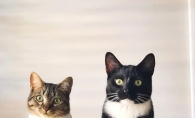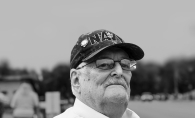Step into David R. Smith’s home studio in Excelsior and a framed painting featuring a cluster of pumpkins arrests your gaze. The pumpkins are so vibrant and realistic, you wonder aloud if it isn’t a photograph. You can tell that Smith is used to this question, because he grins and shakes his head. “Oh no, that’s watercolor,” he says, laughing.
Smith has a variety of tools in his arsenal: paper towels, sponges, brushes, syringes, spray bottles and even razor blades. Seated at his computer, Smith pulls up an image of one of his seascape paintings and points to the areas where he used a razor blade to carve out flecks of sea spray. In other areas, Smith allowed the paints to do all the work. By applying wet paint to a wet canvas, the colors seamlessly meld to create stunning effects.
“You have to relinquish a certain amount of control and know that [watercolor] has a will of its own,” Smith says. “If you try to work against it, it’ll look like you struggled with it.”
Watercolor is Smith’s medium of choice, but it took a visit to the East—literally and figuratively—to prepare him for the unpredictability of the fluid medium.
Twenty years ago, Smith discovered Chinese brush painting, a form of art in which every brushstroke becomes a shape that, put together, make an entire subject. Smith’s mom taped a PBS show for him that featured an artist named Ning Yeh demonstrating the technique. When Smith watched the show, he was amazed at how beautiful and effortless the technique looked. He just had to try it.
Ning Yeh, the artist featured in the show, used to travel from his home in California to the Bloomington Theater and Art Center in Minnesota every summer to teach Chinese brush painting. In 1992, Smith, who had begun studying brush painting on his own, was among Yeh’s students eager for deeper knowledge. “The great thing about Chinese brush painting is the process, because there’s no room for error, you just have to go for it,” Smith says. “It teaches you to be brave and courageous in every brush stroke because you can’t change it; you can’t be timid.”
As a member of a tour group that Ning Yeh organized in July 2000, Smith spent 3 weeks traveling all over China visiting historic sites, ink factories and artists’ studios. After the group left, Smith stayed on for another week to study with two of the artists. One of the artists, interested to see what Smith knew, asked him to paint some bamboo. The outcome was one Smith would never forget. “I had these really small brushes,” he says, “and [the artist] smiled and then he demonstrated with a brush that was three times the size of the brush I was using, and within a minute he had this bamboo that was incredible, and I thought, ‘I need that brush!’ And he says, ‘Oh, you like it? Here you go!’ He just gave it to me. He didn’t care about the brush at all; it was about his ability, his talent, and all his years of practice. It was his skill level that was amazing.”
Later, Smith took a watercolor workshop at Dillman’s Resort in Fond du Lac, Wis. The instructor, Gordon MacKenzie like Yeh, had the uncanny ability to manipulate fluid mediums effortlessly. “I just was amazed at the process and how it looked like he was dancing that brush across the page,” Smith says. Just as when he watched Ning Yeh demonstrate brush painting for the first time, Smith was immediately hooked on watercolor.
Smith feels watercolor has plenty to offer and isn’t sure he’d expand to oil or acrylics. “There are so many different techniques, with wet on wet, and wet on dry, and dry on wet,” says Smith. “The variety of effects you can get with the different techniques is mind-blowing. I don’t think I could get those effects and have as much fun and enjoyment with a different medium.”
To see more examples of Smith’s artwork, visit mnartists.org/David_R._Smith.









